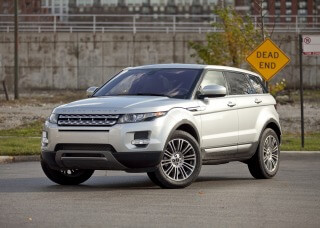
Land Rover’s 2012 Range Rover Evoque knocked us out — every single one of us — with its standout styling, interior accommodations and driving dynamics.
I’ve spent the better part of 20 years explaining to the uninitiated that Land Rover is a manufacturer’s name and Range Rover is a model name. With the introduction of the Range Rover Evoque, three of Land Rover’s four models in the U.S. use the Range Rover name. Why did I bother?
Replacing the LR2, the Evoque is a new model, technically a compact SUV unrelated to Land Rover’s three midsize vehicles: the flagship Range Rover, Range Rover Sport and LR4.
The Evoque comes in two- and four-door versions. Rather than separate trim levels, each Evoque is available with one of three option packages — Pure, Prestige and Dynamic — that represent different color schemes and interior and exterior design tweaks, along with additional features. Customizable elements include contrasting roof colors, 19- or 20-inch alloy wheels, real wood or metal trim, illuminated doorsill scuff plates and more.
A Stunning Vehicle
In either body style, the Evoque is simply a stunning vehicle that drew as much attention out on the road as any all-new model I’ve tested. The design says Land Rover, but it’s clearly something new, characterized by its rising belt line and a downward-sloping roof that, in many color combinations, appears to float because it’s supported by black pillars. The low roofline and squinty windows make it look like a concept car that’s escaped from an auto show — or a traditional SUV that’s been chopped after purchase.
The roof is roughly eye level for a tall adult, about 5 inches lower than it was on the Evoque’s boxier predecessor. The styling suggests an interior compromise, and while there’s some, it isn’t nearly what I’d expected. With 40.3 inches of headroom — an increase of 0.1 inch — the front seats are roomy enough for someone in the 6-foot-tall range. The only anomaly, which I recognize from the LR2, is the raised platform on which the seats are mounted; I felt my heels bumping up against it during longer drives. This annoyance might be my own peculiarity.
Decent Sight Lines
Despite the squinty side and slotlike rear windows, visibility to the rear is surprisingly good: Rear-quarter windows help you peer into your blind spots, the side mirrors are disproportionately large, and the interior rearview mirror provides a decent accounting of what’s behind the Evoque through the short rear window. A backup camera and front and rear sonar parking sensors are standard. If that isn’t enough for you, consider one of the option packages that includes the Surround Camera System: It has five cameras, including, most notably, one of the first true rearview cameras on the market. (It’s not just a backup camera that comes on when the transmission’s in Reverse, this one can display a rear view on the center touch-screen the whole time you’re driving forward.)
Though I love the rearview camera idea, objects in the display were definitely closer than they appeared to be. Even with the view zoomed in, the scale was more like that of a side mirror than the realistic portrayal you get from an interior rearview mirror.
The system also includes cameras in the front and under the side mirrors. Unlike similar features from Infiniti and BMW, Land Rover’s Surround Camera System doesn’t stitch together views of three or four sides of the car to show a single overhead view. The Evoque’s rear camera looks straight back, the side ones look down at the curbs and the front ones look toward the front corners for nosing into an intersection or parking space.
The touch-screen menu lets you select which of these views you wish to see at once, and some of them can be zoomed or panned. It’s pretty elaborate stuff that’s reasonably simple to operate, though some of the touch-screen’s other menus are cluttered and a bit slow to react. I’m not a fan of voice activation, but I have to say Land Rover is onto something by putting text of the available commands on the screen each time you press the voice-command button — an excellent training tool.
I was less enthused by the forward view in our test vehicle because it was equipped with the optional Climate Comfort Package’s heated windshield. As I’ve noted about previous Land Rovers, this feature embeds fine squiggly heater wires in the windshield glass that produce halos around street lights and oncoming headlights. A conventional forced-air windshield defroster is standard, so I could live without the experience of a cut-rate Lasik procedure. Sadly, because of the feature packaging, to get rid of it I’d have to sacrifice the heated front seats and steering wheel, too … .
Comfort & Quality
Along with comfortable seats, the Evoque has an admirably comfortable ride; elsewhere, sport-oriented models like the Acura RDX, BMW X3 and Infiniti EX35 populate the small luxury SUV class. Luxury used to be about comfort; the Evoque still is, at least more than many competitors. Land Rover also offers an optional Adaptive Dynamic Package that includes an adaptive suspension, but the Evoque’s ride was so comfortable I had to check the window stickers to confirm that my test vehicles didn’t have the feature.
I tested base and loaded four-door Evoques. I found the entry-level interior quality to be pretty good, but not exceptional. The dashboard is covered in a synthetic material that’s padded but has an odd, rough texture and unconvincing stitching. (If it’s real stitching, that’s an even bigger failure.) Leather seats are standard, though, and if you want to throw more money at your Land Rover dealer, you can deck out the Evoque’s interior to rival the other Range Rover models: leather-wrapped dashboard, perforated or “premium” leather, pedal finishers, dual video screens for the backseat and more.
The optional backseat video system includes two wireless headsets and an elaborate touch-screen remote control that recharges when docked in the back of the center console. Cool stuff.
Snug Backseat
The backseat is snug, no doubt about it. Adults will sit with their knees raised. In exchange, they get adequate headroom: 39.7 inches in the four-door, which is a 0.3-inch increase over the LR2. Compared with the two-door, or coupe, the four-door provides 1.2 inches more headroom in front. In the rear, there’s 1.5 inches more headroom and 2 inches more shoulder room.
What’s remarkable is how roomy our test vehicles seemed thanks to the standard glass roof. More than simply a panoramic moonroof, the Evoque’s roof is a fixed skylight comprising almost the entire ceiling surface. To backseat passengers, it’s as close as one comes to being in a convertible without actually being exposed.
It’s definitely more cavelike with the powered shade closed. (The shade is fabric, but it’s also opaque, so it doesn’t contribute to the greenhouse effect, as some mesh screens do.)
Small Engine, Big Power
Also new is a 240-horsepower, turbocharged direct-injection 2.0-liter four-cylinder, which moves the Evoque with authority, exhibiting little of the lag for which turbos were long dismissed. No one in his right mind would take the LR2’s gravely five-cylinder over this. Aside from scooting the Evoque to 60 mph in roughly 7 seconds, it boosts EPA-estimated mileage to 18/28 mpg city/highway on premium gas, up from 15/22 mpg in the LR2.
The six-speed automatic transmission is pretty well-behaved, with only occasional hesitation, typically in Drive mode. Calibrated for high mileage, the Drive mode allows the engine to run at very low rpm while cruising, which sometimes produces a slight vibration. The automatic Sport mode keeps the engine clear of this near-lugging condition and isn’t a bad choice for normal driving, as some hair-trigger Sport modes are. Drivers can also shift manually using paddles on the steering wheel.
Respect the Knob
I’ll be the first to bemoan the move away from conventional gear-selector levers and toward all variety of electronic switches that forfeit the tried-and-true convention, but I’ll defend the Evoque’s rotary knob as one of the best alternatives. Borrowed from Jaguar, the knob rises when you start the car. Once it does, you can operate it without looking down: Rotate three clicks clockwise for Drive, two back for Reverse, etc. The latest shifter abominations from BMW and others are a recipe for a wrong-way mishap.
The standard all-wheel drive is a smart system, and the only complaint I have is that it doesn’t seem to apportion more torque to the rear wheels than to the fronts as a default. As a result, it doesn’t enter or exit aggressive corners with the balance it could, but the Evoque otherwise handles very well. You forget how small it is until you toss it about, turn a tight circle or park it. At 3,680 pounds of curb weight, it’s a remarkable 575 pounds lighter than the LR2.
The standard Terrain Response system allows even novice drivers to optimize the Evoque for foul weather or off-road scenarios by matching an icon setting to whatever they see out their window. I didn’t drive the Evoque off-road, but it’s likely to outperform most compact SUVs in such scenarios.
Cargo & Towing
Headroom may have improved in the Evoque, but you pay for its squat design in cargo volume. The LR2 had 26.7 cubic feet behind the backseat and 58.9 cubic feet with the seat folded. The four-door Evoque has 20.3 and 51.0 cubic feet, respectively, and the two-door is smaller still at 19.4 cubic feet and 47.6 cubic feet.
The Evoque’s towing capacity is 1,650 pounds for an unbraked trailer and 3,500 pounds for one with brakes.
Safety
Like other current Land Rovers, the Evoque hasn’t been crash-tested. The brand’s low sales volume in the U.S. suggests it never will be. There are seven airbags: two in front, a knee airbag for the driver, seat-mounted side-impact airbags for front occupants and side curtains that protect outboard occupants in the front and rear seats. Standard safety features include the federally required antilock brakes and electronic stability system. Blind spot monitoring is a notable safety option.
That’s All?
Review cars awhile and you’ll come to recognize a few observations — your own and others’ — that are always good omens for a new model. Chief among them is when people say, “That’s all?” after you tell them how much it costs. I heard that a lot with the Evoque. To be perfectly clear, the Evoque’s price rises quickly and steeply once you add options, and a loaded model hits around $61,000. But the two attributes I consider to be the Evoque’s highest points — its styling and ride quality — come at the base price of $43,145.
Land Rover missed an opportunity by failing to bring its compact car-based SUV, the Freelander, to the U.S. in the late 1990s. By the time it went on sale here in 2002, there were roomier and cheaper car-based alternatives. The LR2 has done little to light fires since 2008. With the 2012 Range Rover Evoque, Land Rover has made up for lost time. It looks like a winner.
Snapshot:
Starting MSRP $43,145–$44,145
MPG
City: 18
Highway: 28
Available Engines
240-hp, 2.0-liter I-4 (premium)
Transmissions
6-speed automatic w/OD and auto-manual
New or Notable
• New compact luxury crossover for 2012
• Two- and four-door versions
• Turbo four-cylinder power
• Six-speed automatic
• Permanent all-wheel drive
What We Like
• Appealing design
• Premium interior
• Surprisingly roomy cabin
What We Don’t
• Narrow cargo area
• Sleek styling may limit visibility
• High starting price































